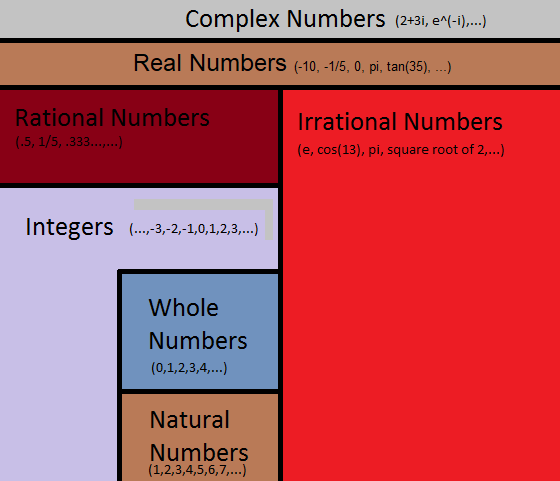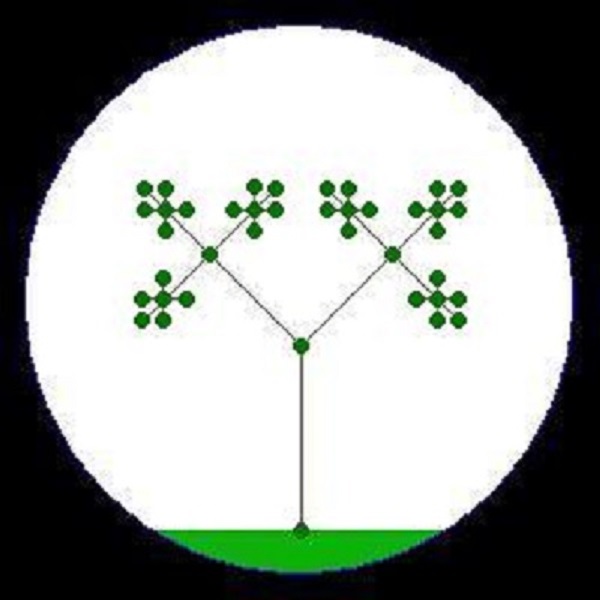“When did they start putting letters in it?”
Below are the some definitions in Modern Algebra that we will use to prove the statement: “Let ☆ be defined on 2ℤ={2n|n∈ℤ} by a ☆ b = a + b. Prove that ⟨ℤ,☆⟩ is a group.” These definitions are assumed to be true and never false. Take your time and try to fully understand what each one means.
Definitions
- Set: a well-defined collection of objects.
- Elements: objects of a set.
Brief intermission from definitions and looking more closely at sets
So, sets are just collections of objects. In our case, we are mostly interested in sets of numbers (but don’t let that stop your imagination from running wild ;-)). You have actually been working with sets of numbers your entire life. For example, we know that -1 is not a natural number but it is an integer. To express that in set notation, we would write: -1∉ℕ and -1∈ℤ. In this case, -1 is an element of the integers but -1 is not an element of the natural numbers. Remember the old picture where the sets of numbers are contained by the set above them?

As an example, Natural Numbers are contained in the Whole Numbers () and Integers are contained in the Rational Numbers (
). So, each block in the picture is a set.
There is also a notation when defining your own set of numbers. For example, let’s say that we want to make a set of integers that are multiples of 5. We would write {5n|n∈ℤ}. This means for every integer in ℤ (which is all of them) we multiple them by 5. So, a piece of what it would look like is {…,-10,-5,0,5,10,…} where each of those numbers would be called elements. Think about how you would define a set that would look at only odd integers.
Back to the definitions
- Subset: A set B is a subset of a set A if every element of B is an element of A, denoted by B⊆A or A⊇B. If B⊆A but B≠A, we will denote that by B⊂A or A⊃B.
- Cartesian Product: Let A and B be sets. The set A⨯B={(a,b)|a∈A and b∈B} is the Cartesian Product of A and B. (So, A and B can be any set that we can think of. Then we are pairing them up with each other to make one element of A⨯B.)
- Relation: A relation between sets A and B is a subset ℛ of A⨯B. For a∈A and b∈B,(a,b)∈ℛ is read as “a is related to b” and is written as aℛb.
- Function: A function ϕ mapping X into Y is a relation between X and Y with the property that each x∈X appears as the first member of exactly one ordered pair (x,y) in ϕ. Such a function is also called a map or mapping of X into Y.
- Binary Operation: A binary operation ☆ on a set S is a function mapping S⨯S into S. For each (a,b)∈S⨯S, we will denote the element ☆((a,b)) of S by a☆b.
- Closed under the operation: Let ☆ be a binary operation on S and let H be a subset of S. The subset H is closed under ☆ if for all a,b∈H we also have a☆b.
All of these definitions have led us up to this point. Now, we will be looking at the meat of Group Theory in Algebra. The definition of a group…
Group: A group ⟨G,☆⟩ is a set G, closed under a binary operation ☆, such that the following axioms are satisfied:
- For all a,b,c∈G, we have (a☆b)☆c=a☆(b☆c). (the operation is associative)
- There is an element e in G such that for all x∈G, e☆x=x☆e=x. (there is an identity element)
- Corresponding to each a∈G, there is an element a′∈G such that a☆a′=a′☆a=e. (for each element in G there is an inverse element)
We are now armed with enough to take on our proof that was advertised above.
Statement: Let ☆ be defined on 2ℤ={2n|n∈ℤ} by a ☆ b = a + b. Prove that ⟨2ℤ,☆⟩ is a group.
Proof: Let ☆ be defined on 2ℤ={2n|n∈ℤ} by a ☆ b = a + b. Let a∈2ℤ, b∈2ℤ, and c∈2ℤ. Then, a=2k, b=2p, and c=2r where k,p,r∈ℤ.
So, (a☆b)☆c=(2k+2p)+2r=2k+(2p+2r)=a☆(b☆c) since adding integers is associative. Hence, ⟨2ℤ,☆⟩ is associative.
Consider e=2•0=0. Since 0∈ℤ and e=2•0=0, e∈2ℤ. So, a☆e=2k+2•0=2•0+2k= e☆a=2•0+2k=0+2k=2k by addition of integers. Hence, a☆e=e☆a=a, making e the identity of ⟨2ℤ,☆⟩.
Consider a′=2(-k). Since k∈ℤ, -1∈ℤ, and the multiplication of two integers is an integer, (-1)•k=-k∈ℤ, making a′∈2ℤ. So, a☆a′=2k+2(-k)=2k-2k=0=e. Hence, each element in 2ℤ has an inverse element.
Therefore, since ⟨2ℤ,☆⟩ is associative, has an identity element, and, for each element in 2ℤ, there is an inverse element in 2ℤ. ⟨2ℤ,☆⟩ is a group.
That is it! Our hard work in understanding the definitions paid off in a big way.
